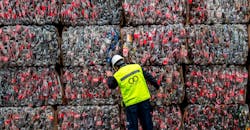Renewable Plastics Are a Huge Untapped Opportunity
This year has seen news of the climate crisis and impact of human development on the environment become front page news around the world—from the Green New Deal, to Greta Thunberg, and Extinction Rebellion in Europe and the rest of the world. Having spent years as a secondary issue, the overpowering urgency of the impending climate breakdown is finally perceived as a crisis by citizens across the globe, shooting up the agenda in terms of importance.
One of the most concerning issues is the problem of plastics and their impact on the planet, particularly our oceans. Experts estimate 12.7m tons of plastics goes into our oceans each year—the equivalent of a full garbage truck every minute. By 2050, there will be more plastic than fish in the oceans, and that’s without the possibility of giants like China and India increasing their plastic usage. Even so-called biodegradable plastic can take years to decompose – yet modern life depends on the material to a huge degree. Getting rid of it entirely simply isn’t feasible because it would involve some unmanageable trade-offs—even reducing plastic packaging in favor of paper comes with an unacceptably high deforestation cost.
These are challenging issues for engineers, manufacturers and those working in industry, with many organizations in the sector considering a circular economy approach—designing out waste and pollution, keeping products and materials in use, and regenerating natural systems.
As this trend gathers pace, more investment in green R&D and in materials innovation will be needed, if we are to see plastics usage minimized—as well as completely reuse or recycle plastics into the ecosystem.
A new plastics economy
A circular economy for plastics is a crucial part of what the Ellen MacArthur Foundation has termed “the new plastics economy” (NPE). The NPE envisions a world where, among other things, all problematic or unnecessary plastic usage is eliminated, products are designed for reuse wherever possible, and any plastic which isn’t reused is either recycled or composted. The willingness to take on the problem is there among corporations: Industry giants like Unilever, Nestle, and PepsiCo have all committed to moving toward a more circular economy with regards to their plastic packaging, while a host of major retailers have announced plans to radically reduce the amount of plastics used, including Walmart and Aldi. However, while we should be encouraged by the ambition of these corporations, there are still many technical problems yet to be solved.
One major hurdle is that, in their current form, many types of plastic can neither be reused nor recycled thanks to the structure of their polymers. While for some plastics there are excellent recycling programs—for example, polyethylene terephthalate, which is used in the manufacture of many plastic bottles, can be recycled and repurposed as carpets or luggage. But most are essentially only feasible as single-use products, such as polypropylene, or difficult to recycle properly like PVC. Industry needs to either find ways to reuse or recycle the existing types of plastic in use, or come up with new materials more suited to a circular economy than our current options – innovation in research and development is going to be critical.
Progress is already being made through companies like Agilyx , which has been able to liquefy and fully recycle polystyrene, a particularly problematic plastic. However, innovations around such “extreme” recycling will only be useful in addressing the challenge if they are able to be scaled up and implemented on an industry-wide scale. To continue making real progress across all sectors, a step change in the amount invested in green R&D is needed. We can already see the impact of such investment in new, ‘miracle’ materials such as borophene—which promises to transform the development of sensors, batteries and catalytic chemistry. The aim is to arm researchers with enough data, so that we see similar transformative outcomes in the field of plastics.
A circular solution
The good news for those in industry is such research could also be extremely profitable, with the MacArthur Foundation estimating that solutions around recycling the 86% of plastic currently going unrecycled could be worth up to $120 billion. Indeed, if even one industry giant—say Amazon or Alibaba—changed its approach to packaging to a more sustainable model, the sheer volume involved would birth entire industries almost overnight. For forward-looking organisations, environmental protection can be extremely lucrative. However, embracing environmentalism and investing in R&D means we’ll inevitably see a concordant boom in the volume of data produced. To avoid a data deluge and to make sure that R&D insights have tangible outputs, industry will need to invest further in methods of accurately capturing, reproducing and harmonizing data.
The challenge is clear—our current economic model is not working. For ourselves, and for the planet we live on, we have a moral, environmental, and economic duty to shift towards a more circular plastic economy as quickly as possible. At the same time, considering how integral plastic has become to modern life, it is unrealistic to imagine that we will jettison it altogether. It’s not just about rejecting unsustainable polymers but also having better, greener replacements available. By investing heavily in green R&D, we can make plastic a sustainable part of our economy that is used, and reused, without damaging ecosystems around the planet. Our researchers have the brains and the talent; it’s simply up to us to support them with the resources.
Phoebe McMellon is a director in the Oil & Gas segment at Elsevier, a global information analytics business specializing in science and health.
About the Author
Phoebe McMellon
Director, Oil & Gas segment
Phoebe McMellon is a director in the Oil & Gas segment at Elsevier, a global information analytics business specializing in science and health.
